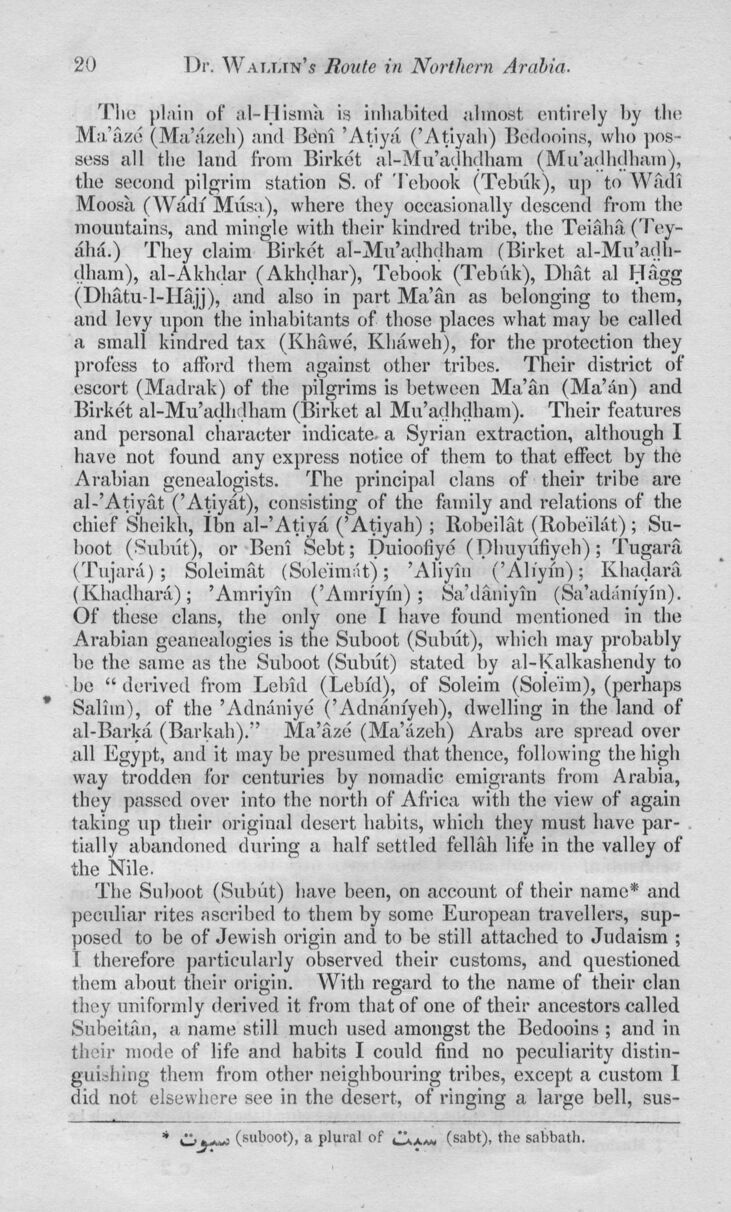
Full resolution (JPEG) - On this page / på denna sida - Route in Northern Arabia

<< prev. page << föreg. sida << >> nästa sida >> next page >>
Below is the raw OCR text
from the above scanned image.
Do you see an error? Proofread the page now!
Här nedan syns maskintolkade texten från faksimilbilden ovan.
Ser du något fel? Korrekturläs sidan nu!
This page has never been proofread. / Denna sida har aldrig korrekturlästs.
[-The-]{+20
l)r. Wallin’s Route in Northern Arabia.
The+} plain of al-Hismk is inhabited almost entirely hy the
Ma’aze (MaYizeli) and Beni ’Atiya (’Atiyah) Bedooins, who
pos-sess all the land from Birket al-Mu’adhdhani (Mu’adhdham),
the second pilgrim station S. of Tebook (Tebuk), up to Wadi
Moosa (Wadf Musa), where they occasionally descend from the
mountains, and mingle with their kindred tribe, the Teiaha
(Tey-ahd.) They claim Birket at-Mu’adhdham (Birket
al-Mu’adh-clham), al-Akhclar (Akhdhar), Tebook (Tebuk), Dhat al Hagg
(Dhatu-l-Hajj), and also in part Ma’an as belonging to them,
and levy upon the inhabitants of those places what may be called
a small kindred tax (Khawe, Kliaweh), for the protection they
profess to afford them against other tribes. Their district of
escort (Madrak) of the pilgrims is between Ma’an (Ma’an) and
Birket al-Mu’adhdliam (Birket al Mu’adhdham). Their features
and personal character indicate- a Syrian extraction, although I
have not found any express notice of them to that effect hy the
Arabian genealogists. The principal elans of their tribe are
al-’Atiyat (’Atiyat), consisting of the family and relations of the
chief Sheikh, Ibn al-’Atiya (’Atiyah); Robeilat (Robe’ilat);
Su-boot (Subut), or Beni Sebt; Duioofiye (Dhuyufiyeh); Tugara
(Tujara); Soleimat (Soleim ;i t) ; ’Aliyin (’Ali’yin); Khadara
(Khadhara); ’Amriyin (’Amrfyfn); Sa’daniyin (Sa’adaniyin).
Of these clans, the only one I have found mentioned in the
Arabian geanealogies is the Suboot (Subut), which may probably
ho the same as the Suboot (Subut) stated by al-Kalkasnendy to
be “ derived from Lebid (Lebid), of Soleim (Soleim), (perhaps
Salim), of the ’Adnaniyb (’Adnanfyeh), dwelling in the land of
al-Barka (Barkah).” Ma’aze (Ma’dzeh) Arabs are spread over
all Egypt, and it maybe presumed that thence, following the high
way trodden for centuries hy nomadic emigrants from Arabia,
they passed over into the north of Africa with the view of again
taking up their original desert habits, which they must have
partially abandoned during a half settled fellah life in the valley of
the Nile.
The Suboot (Subut) have been, on account of their name* and
peculiar rites ascribed to them by some European travellers,
supposed to he of Jewish origin and to be still attached to Judaism ;
I therefore particularly observed their customs, and questioned
them about, their origin. With regard to the name of their clan
they uniformly derived it from that of one of their ancestors called
Subeitan, a name still much used amongst the Bedooins ; and in
their mode of life and habits I could find no peculiarity
distinguishing them from other neighbouring tribes, except a custom 1
did not elsewhere see in the desert, of ringing a large hell, sus-
(suboot), a plural of (sabt), the sabbath.
<< prev. page << föreg. sida << >> nästa sida >> next page >>